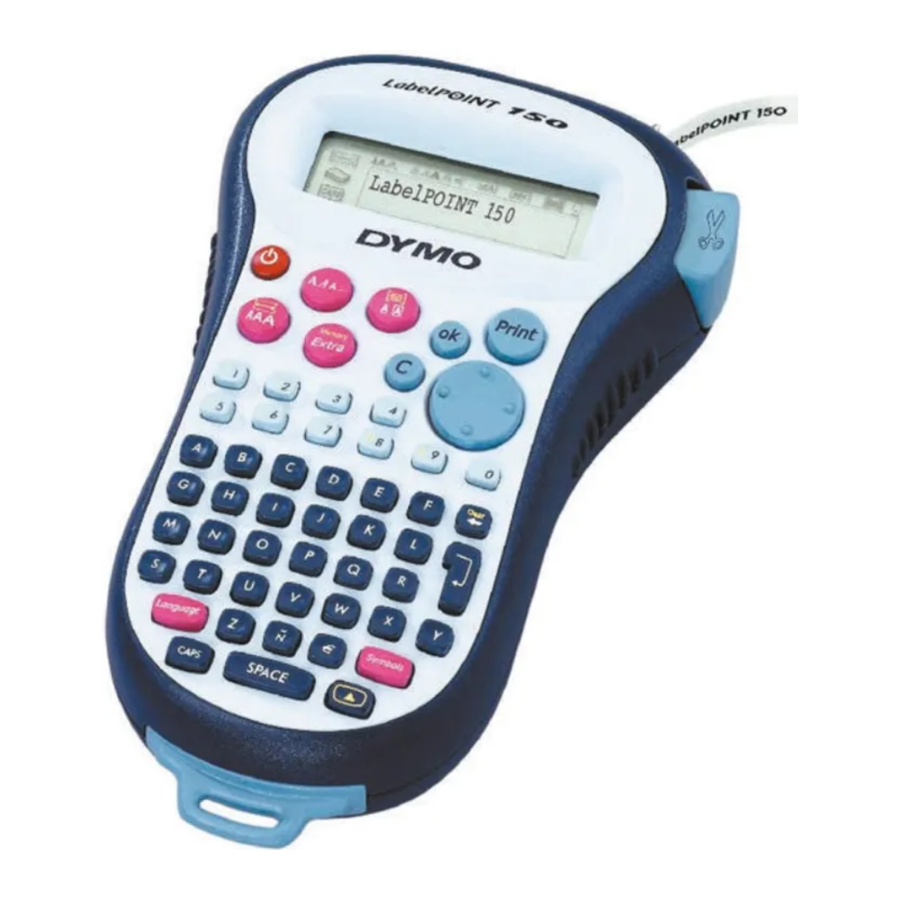
Dymo LabelPoint 150 - Labelling Machine Manual
- User manual (15 pages) ,
- User manual (11 pages) ,
- Quick manual (2 pages)
Advertisement

About Your New Labelmaker
With your DYMO LabelPoint™ 150 labelmaker, you can create a wide variety of high-quality, self-adhesive labels. You can choose to print your labels in many different sizes and styles. The labelmaker uses DYMO D1 label cassettes in widths of 3/8" (9 mm) and 1/2" (12 mm). Label cassettes are also available in a wide range of colors.
Visit www.dymo.com for information on obtaining labels and accessories for your labelmaker.
Warranty Registration
Please complete the warranty registration card and return it to the appropriate Customer Support address within seven days. Visit www.dymo.com/registration for details or to register online.
Getting Started
Follow the instructions in this section to print your first label.
Connecting the Power
The labelmaker is powered by six AAA alkaline batteries. To save power, the labelmaker will automatically turn off after two minutes of inactivity.
To insert the batteries
- Remove the battery compartment cover. See Figure 2.
![Dymo - LabelPoint 150 - To insert the batteries To insert the batteries]()
- Insert the batteries following the polarity markings (+ and –).
- Replace the battery compartment cover.

Inserting the Label Cassette
Your labelmaker comes with one label cassette. Visit www.dymo.com for information about purchasing additional label cassettes.
To insert the label cassette
- Lift the label cassette cover to open the label compartment. See Figure 3.
![]()
The first time you use the labelmaker, remove the protective cardboard insert from between the print head and pinch roller. See Figure 3.
- Make sure the label and ribbon are taut across the mouth of the cassette and that the label passes between the guideposts. If necessary, turn the spool clockwise to tighten the ribbon.
- Insert the cassette with the label and ribbon positioned between the print head and pinch roller. See Figure 4.
![]()
- Press firmly until cassette clicks into place.
- Close the label cassette cover and press
![]() on the power.
on the power.
Selecting a Language
You can select from a number of different language options. By default, the language is set to English. The language option you choose determines the default units of measure (inches or millimeters) and the character set that is available.
To select a language
- Press
![]() .
. - Use the arrow keys to select the language you want and press
![]() .
.
Printing Your First Label
You are now ready to print your first label.
To print a label
- Enter text to create a simple label.
- Press
![]() .
. - Use the cutter lever to cut the label.
Congratulations! You have printed your first label. Continue reading to learn more about the options available for creating labels.
Getting to Know the Labelmaker
Become familiar with the location of the feature and function keys on your labelmaker. Refer to Figure 1. The following sections describe each feature in detail.

Figure 1 DYMO LabelPoint 150 Professional Labelmaker
Power
The  button turns the power on and off. After two minutes of no activity, the power is switched off automatically. The last label created is remembered and displayed when the power is turned back on. The previously selected style settings are also restored.
button turns the power on and off. After two minutes of no activity, the power is switched off automatically. The last label created is remembered and displayed when the power is turned back on. The previously selected style settings are also restored.
You can also use the  button to cancel printing and return to edit mode.
button to cancel printing and return to edit mode.
LCD Display
The labelmaker's LCD display shows a row of thirteen characters. However, you can enter up to 99 characters and spaces.
The display window can accommodate 13 characters. As you type more characters, they begin to scroll to the left. See Figure 5. The number of characters actually displayed can vary due to proportional spacing.

In addition, feature indicators appear on the display to let you know when a feature is selected. See Figure 6.
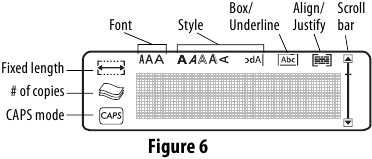
CAPS Mode
The  key toggles capitalization on and off. When CAPS mode is turned on, the CAPS mode indicator is shown on the display and all letters that you enter will be capitalized. The default setting is CAPS mode on. When CAPS mode is off, all letters entered appear in lower case.
key toggles capitalization on and off. When CAPS mode is turned on, the CAPS mode indicator is shown on the display and all letters that you enter will be capitalized. The default setting is CAPS mode on. When CAPS mode is off, all letters entered appear in lower case.
Shift Key
The  key, when used in combination with an alphabet key, changes the case of the selected letter. When used in combination with number keys or function keys, the
key, when used in combination with an alphabet key, changes the case of the selected letter. When used in combination with number keys or function keys, the  key selects the alternate function shown on the key. For example, when you press
key selects the alternate function shown on the key. For example, when you press  , the character to the left of the cursor is deleted; however, when you press
, the character to the left of the cursor is deleted; however, when you press  together, the entire label text and formatting is deleted and the display is ready for you to type a new label.
together, the entire label text and formatting is deleted and the display is ready for you to type a new label.
Space Bar
The  key inserts one or more blank spaces in your text.
key inserts one or more blank spaces in your text.
Clear/Delete
The  key removes the character to the left of the cursor. Pressing
key removes the character to the left of the cursor. Pressing  clears all label text and formatting.
clears all label text and formatting.
Navigation Keys
You can review and edit your label using the left and right arrows on the navigation key. Using  with the left or right arrows moves the cursor to the beginning or end of the label text.
with the left or right arrows moves the cursor to the beginning or end of the label text.
You can navigate through menu selections using the up and down arrow keys, and then press  to make a selection.
to make a selection.
Cancel
The  key allows you to exit from a menu without making a selection or to cancel an action.
key allows you to exit from a menu without making a selection or to cancel an action.
Return Key
The  key inserts a new line on your label.
key inserts a new line on your label.
Extra Key
The  key displays Units, Copies, Preview, and Print Contrast submenus. These features are described later in this User Guide.
key displays Units, Copies, Preview, and Print Contrast submenus. These features are described later in this User Guide.
Formatting Your Label
You can choose from a number of formatting options to enhance the appearance of your labels.

Changing the Font
Three fonts are available for your labels: Arial Narrow, Arial Normal, and Arial Wide.
When you select a font, that font applies to all characters on a label.
To set the font
- Press the
![]() key.
key. - Use the arrow keys to move to the desired font and then press
![]() .
.
Adding Font Styles
You can choose from six different font styles in addition to Normal:
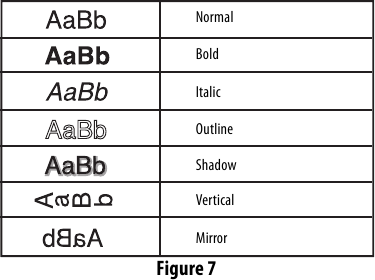
When you select a style, that style applies to all characters. Styles can be used with alphanumeric characters and symbols. See Using Symbols and Special Characters for more information on printing symbols.
To set the font style
- Press the
![]() key.
key. - Use the arrow keys to select a style and press
![]() .
.
Adding Box and Underline Styles
You can further highlight your text by choosing a box or underline style.
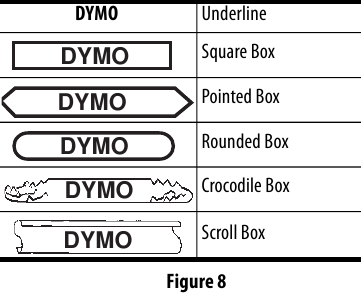
A label can be underlined or enclosed in a box, but not both together.
To add an underline or box style
- Press the
![]() key.
key. - Select underline or a box style and press
![]() .
.
On multi-line labels, both lines are underlined. In box-style mode, all the lines are enclosed in one box style.
Creating Multiple-Line Labels
You can print a maximum of two lines on 3/8" (9 mm) and 1/2" (12 mm) labels.
To create a multiple-line label
- Type the text for the first line, and press
![]() . A new line character
. A new line character ![]() is displayed at the end of the first line, but will not print on the label.
is displayed at the end of the first line, but will not print on the label. - Type the text for the second line.
Using Symbols and Special Characters
Symbols and other special characters can be added to your labels.
Adding Symbols
The labelmaker supports the extended symbol set as shown in Figure 9.

To add a symbol
- Press
![]() . The first row of symbols shown in the table appears in the display.
. The first row of symbols shown in the table appears in the display. - Use the arrow keys to move to the desired symbol. The left and right arrows move horizontally along a row of symbols. The up and down arrow keys scroll vertically through the rows of symbols.
To quickly see a row of symbols, you can press the letter corresponding to the row you want. - When you locate the symbol, press
![]() to add the symbol to your label text.
to add the symbol to your label text.
Adding International Characters
The labelmaker supports the extended Latin character set using RACE technology. Similar to using a mobile phone keypad, if you type a letter multiple times within a very short time, you will scroll through variations on that letter.
For example, if French is selected as the language and you repeatedly press the letter a, you will see a à â æ and so on through all the variations available. The character variations and the order in which the variations appear depend on the language you have selected to use.
Currency Symbols
The currency key $ also uses RACE to scroll through a number of currency symbols:
€ £ $ ¢ ¥
The order these symbols appear depends on the language you have selected.
Printing Options
You can print multiple copies of a label at one time, print fixed-length labels, review label text and format, and adjust the printing contrast.
Printing Multiple Copies
You can print up to 16 copies of a label at one time. When printing multiple copies, a dotted cut-line is printed between each label. To print multiple copies of the label
- Press
![]() .
. - Select Set # Copies and press
![]() .
. - Use the arrow keys to set the desired number of copies to print and press
![]() .
. - Press
![]() to begin printing.
to begin printing.
When printing is finished, the number of copies to print returns to the default value of 1.
Printing a Fixed-Length Label
Normally, the length of the label is determined by the length of the text entered. However, you may wish to make a label for a specific purpose that is a fixed length regardless of the length of the text.
You can specify a fixed length for a label in 0.1" (2 mm) increments between 1.5" (40 mm) and 15.0" (400 mm). The preset fixed length is 4.0" (100 mm). Any change you make to the fixed length setting remains in effect until you change it.
To set the label length
- Press
![]() .
. - Select ON to turn on Fixed Length, then press
![]() .
. - Press the up arrow to increase the length.
- Press the down arrow to decrease the length.
- Press
![]() to set the fixed length.
to set the fixed length. - After printing the label, repeat step 1 and turn Fixed Length OFF; otherwise, all subsequent labels will print with this fixed length.
Previewing Your Label
You can preview the text or format of your label prior to printing. A two-line label is previewed as a single-line label.
To preview your label
- Press
![]() .
. - Select Preview and press
![]() .
. - Select Text or Format and press
![]() .
.
If you select Text, the text of the label scrolls across the display. If you select Format, the format selected displays briefly.
Aligning the Text
When you print a fixed length label you can choose to align the text at the left, center, or right side of the label. For multi-line labels, all lines of text are aligned left, center, and right relative to each other.
To align the text
- Press
![]() .
. - Select the desired alignment and press
![]() .
.
The alignment setting remains active until you reset the alignment.
Adjusting the Print Contrast
You can adjust the print contrast to fine tune the print quality of your label.
To set the contrast
- Press
![]() .
. - Select Set Contrast and press
![]() .
. - Use the arrow keys to select a contrast setting and press
![]() .
.
Using Labelmaker Memory
The labelmaker has a powerful memory feature that stores text and formatting as follows:
- Automatically stores the last three labels printed.
- Allows you to store the text of up to three labels you use frequently.
- Allows you to name and store up to three commonly used label formats.
Storing Label Text
The labelmaker automatically keeps the last three labels printed in a text buffer. In addition, you can store up to three specific labels you use frequently.
To store the current label text
- Press
![]() .
. - Select Save and then Label.
The first of the memory fields is displayed. - Use the arrow keys to move through the fields. You can store new text in any of the memory locations, however, if you select a location that is filled, the previous label text will be overwritten.
- Select a memory location and press
![]() .
.
Your label text is saved and you are returned to the label.
Storing Formats
In addition to label text, you can store up to three specific label formats you use frequently. This feature stores only the formatting information not the label text.
To store the current format
- Press
![]() .
. - Select Save and then Format.
The first of the memory fields is displayed. - Use the arrow keys to move through the fields. You can store a new format in any of the memory locations, however, if you select a location that is filled, the previously stored format will be overwritten.
- Select a field and press
![]() . The word Name? appears in the field.
. The word Name? appears in the field. - Enter a name for the format and press
![]() . The label format is saved and you are returned to the label.
. The label format is saved and you are returned to the label.
Recalling Stored Labels
and Formats You can easily recall labels and formats stored in memory to use at a later time.
To recall labels or formats
- Press
![]() .
. - Select Recall and then Label, Format, or Last Printed.
The first memory location is displayed similar to storing a label or format. - Select a label or format to recall and press
![]() .
.
Caring for Your Labelmaker
Your labelmaker is designed to give you long and trouble-free service, while requiring very little maintenance.
Clean your labelmaker from time to time to keep it working properly.
To clean the print head
- Use the cleaning tool located inside the label compartment lid.
Troubleshooting
Review the following possible solutions if you encounter a problem while using your labelmaker.
| Problem/Error Message | Solution |
| No display |
|
| Poor Print Quality |
|
| Printing | No action required. Message disappears when printing is finished. |
| Too many characters Exceeded maximum number of characters in buffer. | Delete some or all of the buffer text. |
| Too many lines Exceeded maximum number of lines allowed. | Select another format. |
| Insert Tape Cassette Label cassette missing or empty. | Insert a new label cassette |
| Battery low Batteries almost discharged. | Replace batteries. |
| Tape Jam Motor is stalled due to label jam. |
|
Set  Fixed-length label selected and the length necessary to print the label exceeds the selected length. | Following this message, a fixed-length value is displayed which indicates the minimum label length necessary to fit the text. Do one of the following:
|
If you still need assistance, contact DYMO Customer Support. Refer to Contacting Customer Support to locate the contact number for your country.
www.sanfordbrands.com
Produced by: DYMO Corp., Stamford, CT 06902 ©2006
A Division of Newell Rubbermaid
Imported into Canada by Sanford Canada LP, Oakville, ON L6H 5R6
Sanford Australia, 1 - 11 Keysborough Avenue, Keysborough, VIC 3173 - Australia
Sanford New Zealand, 1 Verisimo Drive, Mangere, Auckland 1730 - New Zealand

Documents / Resources
References
Download manual
Here you can download full pdf version of manual, it may contain additional safety instructions, warranty information, FCC rules, etc.
Advertisement
Thank you! Your question has been received!
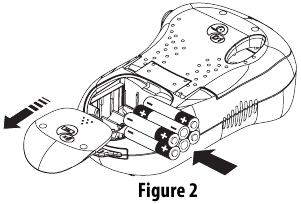
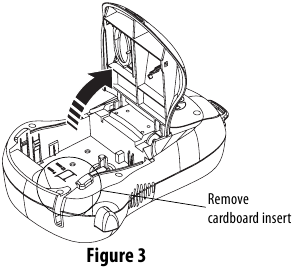
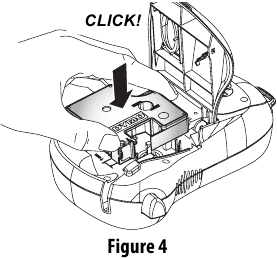
 .
. .
. key.
key. key.
key. key.
key. is displayed at the end of the first line, but will not print on the label.
is displayed at the end of the first line, but will not print on the label. . The first row of symbols shown in the table appears in the display.
. The first row of symbols shown in the table appears in the display. .
. .
. .
.



















Need Assistance?
Do you have a question about the LabelPoint 150 that isn't answered in the manual? Leave your question here.